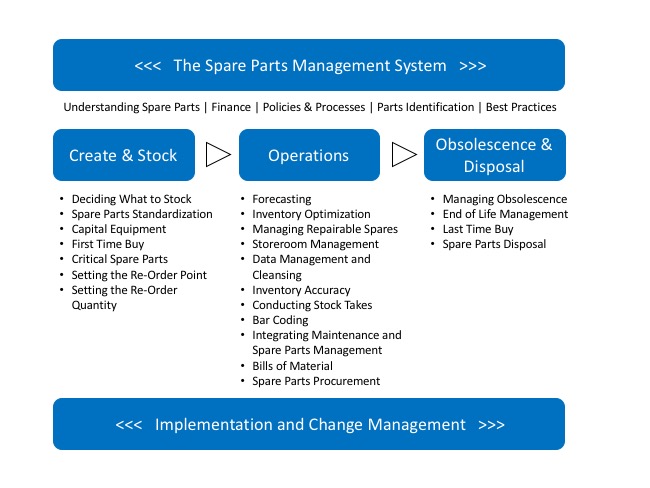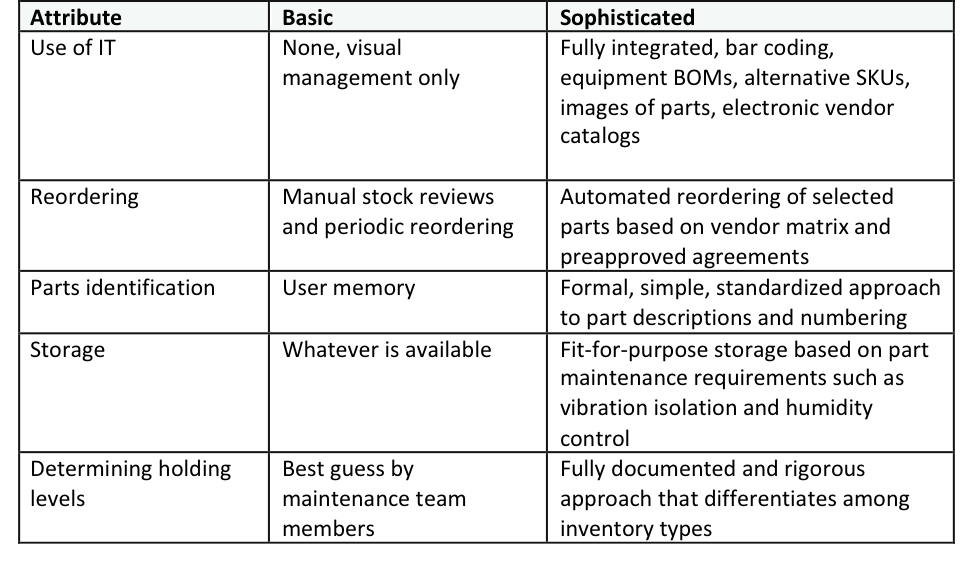Do you know what constitutes a spare parts management system?
Do you know the consequences for not knowing this?
This article explains:
- A Video Explaining the Key Elements of a Spare Parts Inventory Management System
- Just What is a Spare Parts Inventory Management System?
- Definition of a Spare Parts Inventory Management System
- Establishing a Spare Parts Inventory Management System
- Failing to Understand This Has Consequences
What a Spare Parts Management System is Not
Before commencing with any program to improve your company’s spare parts management it is important to understand just what makes up a spare parts management (SPM) system. As a starting point, let’s look at what a SPM system is not.
It is not software.
No matter whether you use a companywide enterprise resource planning program, such as SAP, PeopleSoft, or IFS, or whether you use a stand-alone inventory management program, these programs are not your SPM system. These are tools that you use within your system, primarily for data collection and labor efficiency.
Similarly, bar coding is not a SPM system. Bar coding is also a tool used within your spare parts inventory management system.
So Just What is an SPM System?
An online search using Google provides the following definitions of a system:
1. A set of things working together as parts of a mechanism or an interconnecting network, a complex whole.
2. A set of principles or procedures according to which something is done; an organized scheme or method.
Thinking about these definitions, we can see that an ERP and bar coding are both systems, but on their own they are not spare parts inventory management systems.
Definition of a SPM System
Here is a practical definition of a spare parts inventory management system:
A set of principles, policies, procedures, guidelines, and tools that enable a company to identify procure, control, account for, and dispose of spare parts.
In effect, the spare parts inventory management system encompasses the entire life cycle of asset ownership from determining what to stock to disposing of a part at the end of its life. This is shown in Figure 1.

Figure 1. The spare parts management life cycle
Establishing an Spare Parts Management System
Importantly, establishing a SPM system does not commence with the spare parts themselves; it commences with getting organized.
That is, it is first necessary to determine how the parts that are ultimately selected will be identified, the holding quantities determined, and the parts then stored. Without this your spare parts inventory is likely to be nothing more than a pile of junk in the corner.
Even with an idea as simple as getting organized, there is a scale of sophistication or maturity that needs to be considered.
For example, a simple system of storage bins with a label that includes a part description and maximum holding quantity, where levels are checked weekly and top-up replacements reordered, might be perfectly adequate for a small manufacturer with a handful of machines, a few different types of parts, a small inventory investment, and minimal downtime consequence.
However, that approach would not be suitable for a large, complex manufacturer or processing plant, with millions of dollars tied up in thousands of stock keeping units, with perhaps hundreds of cost centers and downtime costs measured in tens of thousands of dollars per hour.
The system therefore needs to be fit for purpose, based on the circumstance and situation in which it is being applied. Some examples of this are provided in Table 1.

Table 1. Examples of increasing sophistication in the attributes of spare parts inventory management systems
Failing to Understand This Has Consequences
Establishing and determining parameters such as identification, storage, and control, before establishing the rest of the spare parts inventory management system, sets the constraints within which the system must operate. Failing to understand this leads to many companies having mis-alignments between aspects of their spare parts inventory management system that then drive inefficiencies and suboptimal outcomes.
Author: Phillip Slater
You might also be interested in this article on Spare Parts Criticality
You may also be interested in our Spare Parts Management Resource Library.